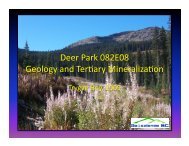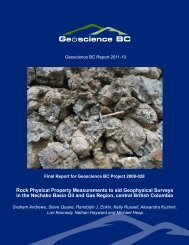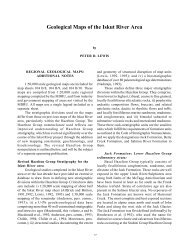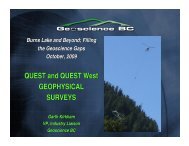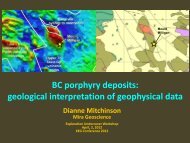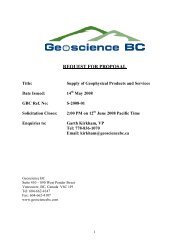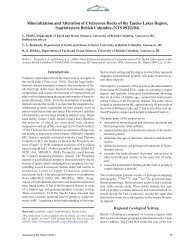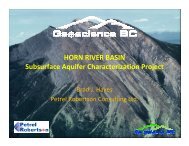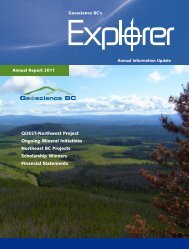Final Report - Geoscience BC
Final Report - Geoscience BC
Final Report - Geoscience BC
You also want an ePaper? Increase the reach of your titles
YUMPU automatically turns print PDFs into web optimized ePapers that Google loves.
4.4. Grounded Electrical Methods (Electrical Resistivity and Induced Polarization)Resistivity can be measured by probes in boreholes or directly from drill core. Resistivity is mosteffective in sedimentary basins. It has been most effectively employed to map alteration arounduranium and gold deposits. 3D pole to pole distributed array acquisition and deeper seekingaudio magnetotelluric surveys are able get the data required to do effective 2D and 3D inversionsacross alteration zones. Resistivity is less effective for direct ore targeting.Induced polarization (IP) has a long history of use and is effective at mapping large areas ofdisseminated pyrite mineralization. The method images large areas of phyllic alteration withdisseminated sulphides, as well as large pyrite–sericite alteration zones in volcanic systems.Geology – IP inversions take significant computational time and are still under development.Any targeting generated by inversions require thorough integration with deposit models andgeology of the target areas. Complete borehole logging is needed to sort out alteration zonationand vectoring in such large alteration systems. IP probes can be used in boreholes. Geochemicalanalyses of sulphur and visual estimates of sulphides in boreholes are inexpensive proxies forborehole IP surveys. IP surveys are also effective for Ni-Cu-PGE veins with high electricalchargeability. Radio imaging (RIM) is a complimentary tool, used across two boreholes, that canimage highly conductive veins.4.5. Audio MagnetotelluricsAudio Magnetotelluric Surveys (AMT) are increasingly popular for mapping conductivity andresistivity below 700 m. It is being applied to deep nickel and uranium exploration and providesa deeper extension to shallower IP-DC resistivity surveys. The latest software is venturing into3D imaging of conductivity and resistivity.4.6. Radiometric Gamma Ray SurveysGamma rays penetrate approximately one half meter into the ground. Spectral gamma andmagnetic surveys are useful for regional mapping of porphyry systems and some uraniferousterranes, for intrusions and uraniferous mineralization and boulders. The integration of magneticswith radiometrics in these surveys is quite effective for the corresponding detection of faultstructures and magnetite-rich intrusive zones and potassic alteration. Such spectral gamma ray7





